- Home
- About the Ainu people TOP
- Ainu Historical Events
Ainu Historical Events
Orange-colored parts or lines are activity of Ainu Assocoation of Hokkaido
| 12th century | Satsumon culture (distributed throughout Hokkaido and the Northern regions of Honshu), which forms the basis of Ainu culture, changes in the mid-12th century. The introduction of metal implements from other regions and lacquerware from the Japanese mainland via trade makes the manufacture of wooden and bark utensils possible, and Satsumon culture's characteristic ceramics and pottery die out. The basic elements comprising Ainu culture (which also uses wooden utensils) appear in the latter part of this century. |
| 13th century | On the island of Ezo (present-day Hokkaido), trading between local Ainu leads to the development of larger regional groups. Societies form in which the heads govern groups. |
| About 13th century | Through economic and military expansion, some Ainu from Hokkaido move to Southern Sakhalin. |
| 1263 | Sakhalin Ainu (guwei) drive the forces of Nivkh (Giriyak) to the mouth of the Amur and directly confront the forces of Yuan, which arrive to rescue Nivkh. |
| 1356 | "Suwa Daimyojin Ekotoba" (explanation on a picture scroll of the God of Suwa) created. "Wajin" (Japanese) in Honshu acknowledge great difference among regional groups of the Ainu. In other words, the Ekotoba indicates that three groups of Ainu peoples, "Hinomoto," "Karako" and "Watarito," live on the island of Ezo-ga-Chishima(present day Hokkaido) and describes the details of each group. |
| 1456 | According to "Shinra-no-Kiroku" (Records of Shinra), Ainu uprisings continue over an approximate 70-year span from 1456 to 1525. There is a series of conflicts between the Ainu and Wajin, who have established economic bases in southern Oshima, Hokkaido. |
| 1457 | Koshamain, leader of the Ainu rises in arms. Ainu forces capture the two forts of Mobetsu and Hanazawa and other forts. Many "Shamo" (Japanese) living in the area between Mukawa and Yoichi are killed. |
| 1550 | Using "Iteki-no-Shosen-Orai-no-Hatto" (Act for the Traffic of Commercial Vessels of Aliens) in "Shinra-no-Kiroku" as a basis, Lord Kakizaki of Matsumae negotiates with the heads of the Ainu in southern Oshima. The Ainu people tacitly accept the presence of a Wajin settlement area (Wajinchi) in exchange for the distribution of a portion of taxes collected from commercial vessels traveling across the sea from Honshu to the island of Ezo. This can be interpreted as Wajin's recognition of Ainu's "quasi-rights" to land and can be regarded as negotiations concluded between the Ainu and Wajin almost as equals. |
| 1604 | Lord Yoshihiro Matsumae receives from Ieyasu a black-sealed shogunate license to trade, giving him a monopoly on trade with the Ainu all over the island of Ezo. |
| 1648 | Battles between the Shibechari Ainu and the Hae Ainu occur. |
| 1669 | Shakushain, leader of the Shibechari Ainu, leads Ainu all over Ezo as they rise in arms against the Japanese in response to a regional dispute over hunting and fishing rights. It was the largest conflict ever between the two people. When peace negotiations eventually begin, the Matsumae clan poison Shakushain at a banquet and the war ends. |
| 1720 | Subcontracting system becomes popular on island of Ezo. Under this system, the Matsumae clan and its followers entrust their trading post management rights with the Ainu to Wajin merchants and receive business taxes from them. |
| 1789 | The Kunashiri Menashi Ainu, who were forced by the local Japanese merchants to work at fishing stations on Kunashiri in the Kurile Islands rise in arms in response to cruel treatment and harsh working conditions. 37 Ainu leaders are executed by Matsumae troops. |
| 1799 | The Tokugawa shogunate takes over direct government of the eastern area of the island of Ezo. |
| 1807 | The Tokugawa shogunate takes over direct government of the western area of the island of Ezo. The Matsumae clan is transferred to Yanagawa, Ohshu (present-day Tohoku region). |
| 1821 | The Tokugawa shogunate returns the island of Ezo to the Matsumae clan. |
| 1854 | -The Tokugawa shogunate requisitions Hakodate from the Matsumae clan and establishes the Hakodate Magistrate. -Conclusion of the Treaty of Shimoda (Russo-Japanese Friendship Pact) between Japan and Russia. The Kuril islands boundary is drawn at the Uruppu waterway, and Sakhalin is designated a shared living area where nationals of both countries may live. |
| 1855 | The Tokugawa shogunate again directly governs the island of Ezo. The shogunate abandons the non- assimilation policy and adopts a policy of education, protection and assimilation of the Ainu. |
| 1869 | Colonization Commission established. The island of Ezo renamed Hokkaido. The island of Kita Ezo renamed Karafuto (Sakhalin). |
| 1871 | The following Ainu customs are banned: burning a family's house and moving elsewhere after the death of a family member; women's tattoos; men's earrings. The Ainu are encouraged to engage in agriculture and learn the written and spoken language of the Wajin. |
| 1872 | Based on Article 7 of the Land Regulation, land where the Ainu have conducted fishing, hunting or logging is expropriated and divided into lots possessed by individuals or managed by villages. |
| 1875 | 108 households (841 individuals) of Sakhalin Ainu are forcibly transported to Souya, Hokkaido under the Treaty of Saint Petersburg (The Russo-Japanese Sakhalin, Kuriles Exchange Treaty). |
| 1877 | Based on Article 15 of the Hokkaido's Ordinance for Issuing Land Certificates, forests and wilderness are brought under government ownership. Based on Article 16 of the same ordinance, all types of land where the Ainu live are incorporated into Government Land Class Ⅲ. |
| 1878 | The Colonization Commission applies the administrative name "Former Aborigines" to the Ainu. |
| 1886 | Hokkaido Government established. Based on Hokkaido's Regulation for Transferring Government Land to Private Ownership, undeveloped parcels of government land (100,000 tsubos (330,000㎡) or less per person) are transferred to private ownership, or leased without compensation to the private sector. |
| 1893 | Masanosuke Kato, a member of the Imperial Diet, submits a bill for the Hokkaido Aborigines Protection Act (9 articles) to the 5th Imperial Diet session. The bill is amended but rejected. |
| 1895 | At the 8th Imperial Diet session, six members of the Imperial Diet, including Jubi Suzuki, question the government, claiming injustice regarding management of the Ainu's common property and leased land. The six members submit a bill for the Hokkaido Aborigines Protection Act (7 articles). However, the bill is not passed. |
| 1898 | The government submits a bill for the Hokkaido Former Aborigines Protection Act. The bill is passed by the House of Representatives. |
| 1899 | The Hokkaido Former Aborigines Protection Act promulgated and put into force. |
| 1901 | The Regulation for the Education of Former Aborigines' Children, which regulates primary school education for Ainu children promulgated (abolished in 1936). |
| 1910 | Law on land ownership by aliens established. Domestic laws amended, allowing land ownership by aliens in Japan, in response to the revision of international conventions. Hokkaido was exempted from this law because of its status as a colony (like Taiwan and Sakhalin) of Japan, according to the reason for submitting a legislative bill to the Imperial Diet. |
| 1911 | Fur-seal protection convention concluded. In the international convention concluded between the U.S., the Soviet Union, Canada (then British territory) and Japan, the Ainu were considered as "aborigens or native" in the same way as the Aleuts and Indians, and were given comparable hunting rights. |
| 1919 | First revision of the Hokkaido Former Aborigines Protection Act. "Diseases, Injuries and Treatment " added to Articles 5 and 6. |
| 1937 | Second revision of the Hokkaido Former Aborigines Protection Act. Examples of items not subjected to restrictions on ownership added to Article 2. "Agricultural tools and seeds" in Article 4 superseded by "Tools necessary for making a living." "Funds for the improvement of inferior houses" and "Facilities and support necessary for protection" inserted into Article 7. Articles 9 and 11 deleted. |
| 1946 | -Third revision of the Hokkaido Former Aborigines Protection Act. Articles 4, 5 and 6 deleted. -The incorporated "Ainu Association of Hokkaido" (Hokkaido Ainu Kyokai) established. |
| 1947 | Fourth revision of the Hokkaido Former Aborigines Protection Act. The provisions of local tax and registration tax of Article 2-2 eliminated. |
| 1948 | The Ministry of Agriculture and Forestry issues a memorandum that land originally granted to the Ainu under the Hokkaido Former Aborigines Protection Act is also included in land to be bought under farmland reforms. |
| 1961 | "Hokkaido Ainu Kyokai" renamed "Hokkaido Utari Kyokai."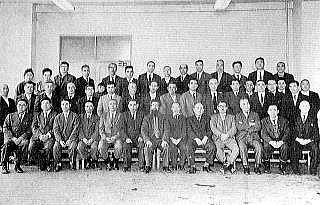 Commemorative photograph of the general assembly on the reformation of Hokkaido Ainu Association as the "Hokkaido Utari Kyokai", Sapporo Fisheries Assembly Hall, 10 April 1960. |
| 1964 | The Administrative Management Agency recommends that the Hokkaido Former Aborigines Protection Act be repealed. |
| 1968 | Fifth revision of the Hokkaido Former Aborigines Protection Act. Article 7, item (1), "School expense allowances" and item (2), "Funds for the improvement of houses" deleted. The Administrative Management Agency asks for the views of the Hokkaido Government regarding the repeal of the Hokkaido Former Aborigines Protection Act. The Hokkaido Government Department of Public Welfare objects to the repeal of the Act, saying it is premature. |
| 1970 | The Hokkaido Association of City Mayors resolves that the Hokkaido Former Aborigines Protection Act be repealed. At the general meeting, the Ainu Association of Hokkaido adopts a resolution to fight repeal of the Hokkaido Former Aborigines Protection Act. |
| 1982 | At the general meeting, the Ainu Association of Hokkaido confirms former occupants' rights in the Northern Territories and Hokkaido and adopts a resolution calling for the repeal of the Hokkaido Former Aborigines Protection Act and enactment of a new law. |
| 1984 | At the general meeting, the Ainu Association of Hokkaido adopts the "Draft Law concerning the Ainu people".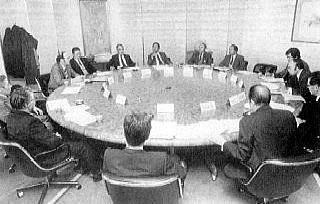 The Utari Affairs Council, private advisory body to the Mayor of Hokkaido, convened 1984 6 December to 22 March 1988. (photograph courtesy of the Hokkaido Shinbun) |
| 1986 | Prime Minister Nakasone's comments on "intellectual standards" represents the claim that Japan is a "mono-ethnic nation,"evoking protests and criticism. |
| 1987 | Ainu Representatives first participate in the 5th U.N. Working Group on Indigenous Populations in Geneva, Switzerland and speak on Ainu affairs. Ainu representatives continue to participate in following meetings. |
| 1988 | The Utari Affairs Council, a private advisory organ to the Governor of Hokkaido, reports on the need for enactment of a New Ainu Law, for which the Ainu Association of Hokkaido petitions. |
| 1989 | -The ILO Conference in Geneva, Switzerland revises the international treaty (No. 169) to disavow the past encouragement of assimilation and to promote indigenous people's enjoyment of legitimate rights to their uniqueness and social, economic and cultural development. -The national government establishes a committee to examine the disputed points of a Law Concerning the Ainu People. |
| 1990 | The United Nations resolves to declare 1993 the International Year of Indigenous People. |
| 1991 | A group headed by Erica Irene Daes, Chairperson of the U.N. Working Group on Indigenous Populations, inspects the status of the Ainu people. Symposium are held in Tokyo and Sapporo. |
| 1992 | Giichi Nomura, Executive Director of the Ainu Association of Hokkaido, makes a speech as a representative of indigenous people at the opening ceremony of the U.N. General Assembly "International Year of Indigenous People." (see other part in this H.P.)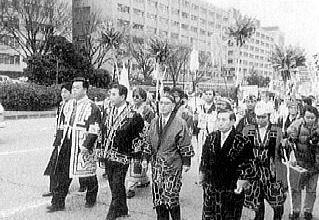 Demonstration march calling for the enactment of a "New Law" concerning the Ainu People, March 1992. |
| 1993 | -Ms. Rigoberta Menchú Turn, Guatemalan indigenous person, the 1992 Nobel Peace Prize winner and a U.N. Goodwill Ambassador for the International Year of Indigenous People is invited to Hokkaido. -Various events commemorating the "International Year of Indigenous People" are held throughout Japan. -The United Nations resolves that the 10 years starting from December 10, 1994 will be the "International Decade of Indigenous People." 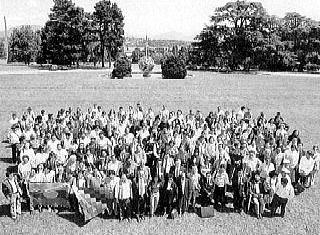 Commemorative photograh at the close of the 11th Session of the United Nations Working Group on Indigenous Populations, Geneva, Switzerland, July 1993. |
| 1994 | The United Nations resolves that August 9 will be celebrated every year as the "International Day of Indigenous People" during the "International Decade of Indigenous People." |
| 1995 | -Among the ruling parties (Liberal Democratic Party, Social Democratic Party of Japan and Sakigake Party), a project team to examine the New Ainu Law is formed. -The Round Table for Policy on the Ainu People (a private advisory body of the Chief Cabinet Secretary / Chairperson: Masami Ito) is established. 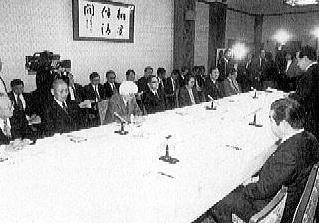 The Round Table for Policy on the Ainu People, private advisory body to the national Chief Cabinet Secretary, convened 30 March 1995 to 28 March 1996. (photograph courtesy of the Hokkaido Shinbun) |
| 1996 | A Report is submitted by the Round Table for Policy on the Ainu People. -Sapporo District Court hands down the Nibutani Dam decision. -Enactment and carrying out of the Law for the Promotion of Ainu Culture and the Dissemination and Advocacy of Knowledge in respect of Ainu Traditions, see (other part in this H.P.) (the Hokkaido Former Aborigines Protection Act is simultaneously repealed). |
| 1997 | -Establishment of the Foundation for Research and Promotion of Ainu Culture. -The Ministry of Justice's Commission on the Promotion of Measures for Human Rights Protection holds its first hearing of the Ainu Association's views on the human rights situation of the Ainu people. |
| 1999 | -April 1999 to April 2001 the Smithsonian Institution's National Museum of National History, Washington U.S.A., holds a Special Exhibition entitled "Ainu: Spirit of a Northern People". -Hokkaido - the "Fundamental Plan Regarding the Re- creation of Traditional Living Spaces" is drawn up and submitted to the national government as a proposal for the early stages of iwor (traditional living spaces) development. -The Ministry of Justice's Commission on the Promotion of Measures for Human Rights Protection holds its second hearing of the Ainu Assosiation's views on the human rights situation of the Ainu. |
| 2000 | -A National Round-Table on Measures to Promote Ainu Culture and Other Matters is established, and begins examining issues including the re-creation of iwor -A separate Hokkaido Round Table on Measures to Promote Ainu Culture is established in Hokkaido. |
| 2001 | -The United Nations Commission on the Elimination of all forms of Racial Discrimination considers Japan's First and Second periodic reports under the Convention. Representatives of the Ainu Associastion attend the session and lobby the Commission. |
| 2002 | -"Towards the Realisation of the Re-creation of Traditional Living Spaces (iwor)" is submitted to the Hokkaido and national governments with the request for the urgent re-creation of iwor. -A session of the National Round-Table on Measures to Promote Ainu Culture and Other Matters is held (presided over by the national government). -The United Nations Special Rapporteur on Indigenous People, Radolfo Stavenhagen is invited to Hokkaido, and provided with information regarding the human rights situation of the Ainu people. |
| 2003 | -The abovementioned Special Rapporteur submits his report, which includes reference to the Ainu people, to the UN Commission on Human Rights -Ainu views are presented to the House of Councillors Commission on the Constitution. An appeal is made for the consolidation of legal measures and improvement of the Ainu human rights situation etc. |
| 2004 | U.N. General Assembly adopts second UN International Decade of the World's Indigenous People, starting on January 1,2005. |
| 2005 | Annual Meeting of Japanese Society of Cultural Anthropology held. Representatives of the Ainu Association of Hokkaido make presentations and proposals at a special symposium and other sessions (printed in "Challenges Facing Modem Cultural Anthropology" published in March 2007 by Sekaishisosha Co., Ltd.). Mr. Doudou Dien, Special Rapporteur on modem forms of ethnocentrism, racism, xenophobia and intolerance at U.N. Commission on Human Rights, visits Hokkaido, holds discussions with top official of Ainu Association of Hokkaido and inspects Biratori and Shiraoi. Mr. Dien also provides information concerning political, legal, cultural and ethical measures for the Ainu. Survey results concerning the Ainu included in U.N. documents. National Round-Table on Measures to Promote Ainu Culture and Other Matters puts together "Basic Concept Regarding the Realization of the Re-creation of Traditional Living Spaces (iwor)" (advanced implementation in July 2006). |
| 2006 | Inquiries made in writing to President of Japanese Society of Cultural Anthropology concerning surveys on archaeological Ainu remains (specifically, a. actual conditions of collecting remains of the deceased; b. research accomplishments; c. storage of remains, consoling the souls of the deceased and so forth in the past and future). The President replies that efforts will be made in earnest to address the issues raised, and that research institutions managing the ashes of the Ainu will be provided with explanations and requests for cooperation and investigation results will be compiled. National government implements project to realize re-creation of traditional living spaces (iwor) in Shiraoi district ahead of other districts. |
| 2007 | Declaration on the Rights of Indigenous Peoples adopted by U.S. General Assembly. Japan votes for favour. 144 favour; 4 against; 11 abstentions; 33 absent |
| 2008 | National government adds Biratori district to Shiraoi district where project to realize re-creation of traditional living spaces (iwor) is underway, and sets fiscal 2010 as target year of advanced implementation. The Japanese Diet unanimously adopted a "Resolution Calling for the Recognition of the Ainu People" as an Indigenous People in June. The Government of Japan established the 'Advisory Panel of Eminent Persons on Policies for the Ainu People' to make efforts to establish comprehensive Ainu Policy. |
| 2009 | "Hokkaido Utari Kyokai" renamed "Hokkaido Ainu Kyokai", English name is the same "Ainu association of Hokkaido". In July, the Panel compiled a report and submitted it to the Government of Japan. In December, the Government of Japan decided to set up the 'Meeting for Promotion of the Ainu Policy'. |
| 2010 | Ainu association of Hokkaido submitted the Information to Committee on the Elimination of Racial Discrimination 76th Settion. |

